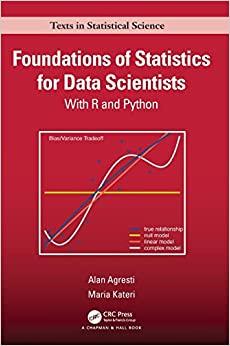For n observations {yi}, let y(1) y(2) y(n) denote theirorderedvalues,called order statistics. Let
Question:
For n observations {yi}, let y(1) ≤ y(2) ≤ ⋯ ≤ y(n) denote theirorderedvalues,called order statistics. Let qi bethe i~(n + 1) quantileofthestandardnormaldistribution,for i = 1. ...,n. When {yi} are arandomsamplefromanormaldistribution,theplotofthepoints
(q1, y(1)), ..., (qn, y(n)) should approximatelyfollowastraightline,morecloselysowhen n is large. This normal quantileplot is aspecialcaseofa quantile-quantile (Q-Q)plot. The R appendixofthisbookpresentsdetails.
(a) Randomlygenerate(i) n = 10, (ii) n = 100, (iii) n = 1000 observationsfroma N(0, 1)
distribution andconstructthenormalquantileploteachtime,usingsoftwaresuchasthe R functions rnorm and qqnorm. Notethatas n increases thepointsclustermoretightly along theline y = x, whichyoucanaddtotheplotwithcommand abline(0, 1).
(b) Randomlygenerate1000observationsfroma N(100, 162) distribution ofIQ’sandcon-
struct thenormalquantileplot.Whatistheslopeofthelineapproximatingthesepoints?
(c) Randomlygenerate1000observationsfromthe(i)exponentialdistribution(2.2),(ii)uni-
form distributionover(0,1),usingsoftwaresuchasthe R functions rexp and runif. Con-
struct thenormalquantileplotineachcase.Explainhowtheyrevealthenon-normality of thedata.
(d) Forcase(ii)in(c),findappropriateuniformquantilesforwhichthe Q-Q plot wouldbe approximatelylinear.Constructtheplot.
Step by Step Answer:

Foundations Of Statistics For Data Scientists With R And Python
ISBN: 9780367748456
1st Edition
Authors: Alan Agresti





